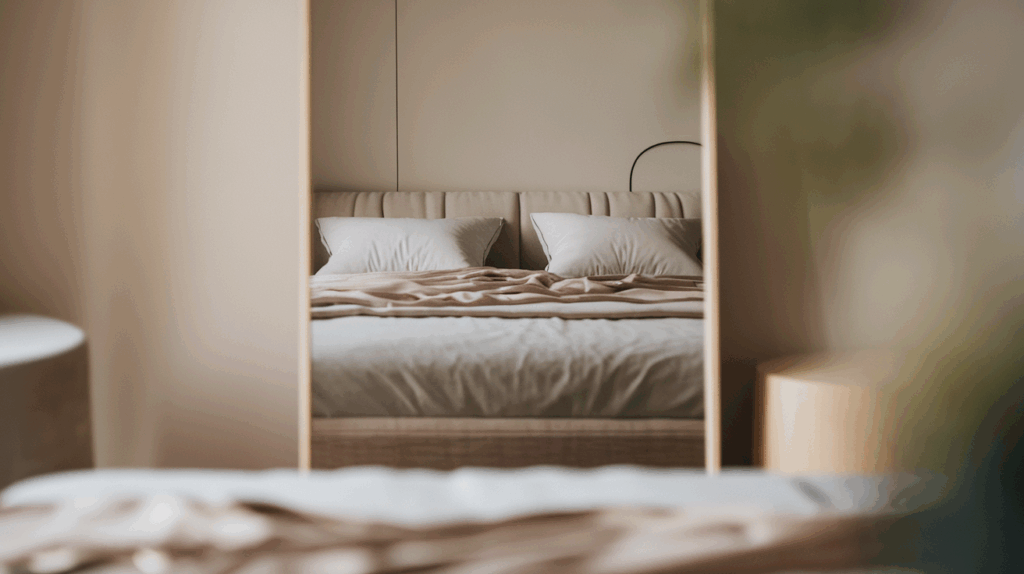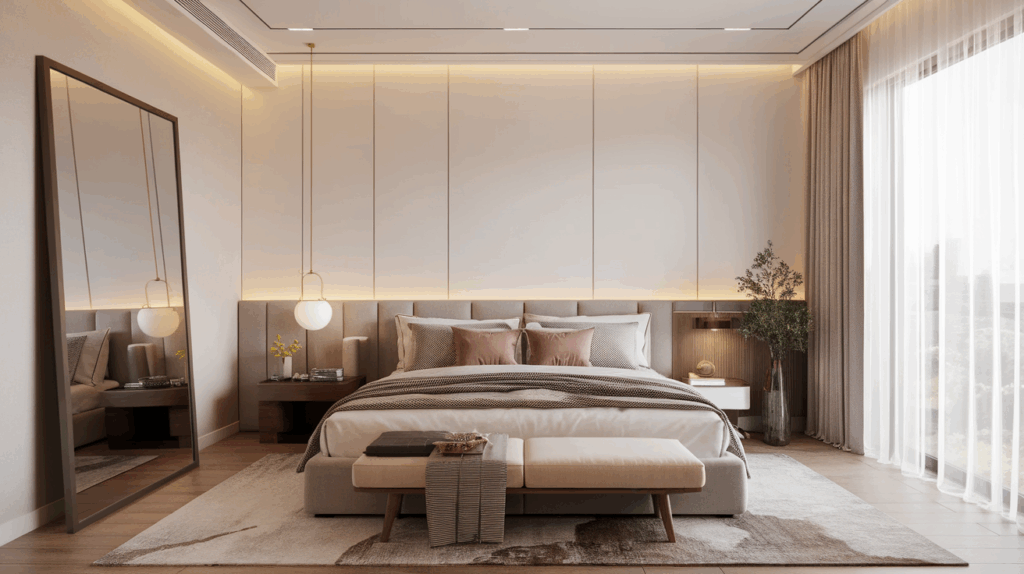When you consider adding a mirror to your bedroom, placing it opposite your bed might feel like a harmless idea. I often see this layout in photos, and your space may look bigger or brighter that way.
Still, many traditional belief systems and practical experts suggest that this setup can interfere with sleep, energy flow, and emotional comfort.
Across Feng Shui, Vastu, and other cultural frameworks, people warn against mirrors directly facing the bed because they can reflect energy, create restlessness, or stir anxiety.
In this guide, I share what these traditions say, what science adds, and what you can do if your mirror currently faces the bed.
I will also explain when a mirror might actually work well in your space and how to adjust it without giving up style or function.
By the end, you’ll feel more confident deciding what’s right for your room and your sleep.
Is It Bad to Have a Mirror Facing Your Bed?

Many cultural traditions say yes, and not just for superstitious reasons. In Feng Shui, mirrors facing the bed are believed to reflect energy, disrupting rest and causing insomnia or anxiety.
In Vastu Shastra, they’re thought to bounce energy around the room, preventing calm sleep and even stirring conflict between partners. Some say mirrors reflect your soul during sleep, leading to unease or disturbed dreams.
Even without spiritual beliefs, a mirror that reflects you while you sleep might feel unsettling.
Waking up to see a movement or shape in the glass can confuse your brain, making you feel alert when you should be resting.
If your sleep feels restless or your room never seems to relax, consider moving the mirror or covering it at night.
What Cultural & Feng Shui Teachings Say
In traditions like Chinese Feng Shui and Indian Vastu, mirrors act as energy amplifiers. When placed facing the bed, they are thought to reflect and multiply energy during sleep, possibly leading to disturbed rest or emotional imbalance.
Others believe a mirror facing the bed could introduce a “third presence” between partners, subtly affecting intimacy or relationships.
Certain superstitions even suggest the mirror can capture or redirect a part of the soul while sleeping.
Practitioners suggest that reducing this reflected presence helps calm stagnant energy.
For you, this may mean moving or covering the mirror to help the bedroom feel less charged. Cultural tradition places a strong emphasis on creating a nurturing space for rest.
How Mirrors May Affect Your Sleep
Mirrors can influence how calm or alert you feel in your bedroom, even without any connection to superstition or cultural beliefs.
- Subtle reflections of movement or light may trigger your brain to stay alert, even while you’re trying to rest.
- This alertness can make it harder to fall asleep or cause frequent awakenings during the night.
- Shadows or reflections can give the unsettling feeling of being watched, even if you logically know you’re alone.
- Even without Feng Shui, many people find they sleep better in rooms without mirrors facing the bed.
- Reducing visual distractions, like reflections and shifting light, often leads to deeper, more restful sleep.
How Light Impacts Mirror Placement
Mirrors reflect everything: light, movement, and even glare. A mirror facing a street lamp or morning sunlight can bounce brightness onto the bed, enough to irritate sensitive sleepers.
North-facing bedrooms often show cooler tones and reflections looking sharper, while southern or western exposure softens the mirror’s impact.
If you already have a mirror opposite your bed, watch how it behaves throughout the day.
You may notice glare at dawn or dusk, or early reflections that disturb your rest. Adjusting its angle or covering it at night can help maintain a quieter, calmer feel.
Smart Ways to Adjust Mirror Placement

If your mirror currently faces the bed, you have options that still let you keep it stylish:
- Reposition the mirror so it doesn’t directly face where you sleep; side angles or wall placements can still add brightness and interest.
- Use a covering for night hours, such as draped fabric, sliding panels, or shutters help block reflection during sleep.
- Apply a frosted or decorative film that softens the reflection; you still get light play but no clear image of the bed.
- Choose a mirror that reflects decor rather than the sleeping area, art, or natural features like a plant or artwork, which can be highlighted without increasing visual stimulation.
With these simple changes, you preserve the mirror’s functional and aesthetic role while minimizing potential discomfort.
What Science Says About Mirrors and Sleep
While no formal studies show that mirrors cause bad luck, neuroscience shows that the brain responds to visual input, even from peripheral vision, during sleep transitions.
A flicker of movement or shifting glare can interrupt sleep cycles, especially in light sleepers.
The question becomes one of perception: if your environment causes subtle alertness, it may reduce restfulness over time.
Reflective surfaces can also create body image awareness in low light. For some people, seeing their silhouette or movement at night can heighten anxiety or self-consciousness.
Even if it’s just subconscious, it may shape how peaceful the sleep experience feels.
Designing with Mirrors the Smart Way
Many people design with mirrors in mind and don’t want to remove them entirely. If a mirror enhances your space, you can still have it by adapting the placement:
- Angle the mirror diagonally so it avoids reflecting the bed directly
- Place a small table or decorative feature between the bed and the mirror to block the view
- Cover the pane during bedtime with a fabric or removable panel
- Use a mirror with a matte backing that doesn’t reflect clearly at night
In this way, you preserve visual appeal and keep restfulness intact.
When Mirrors Facing the Bed Might Work
Some bedrooms handle mirror placement better than others. If you love the way a mirror looks in your space, there are ways to keep it without hurting your sleep. This is how to make it work:
- Big Rooms Help: In large or open bedrooms, the mirror might not reflect the bed clearly, so it feels less distracting.
- Reflect Light, Not the Bed: Aim the mirror to show windows, lamps, or wall art instead of your sleeping area.
- Soften Reflections: Use frosted film or textured glass to blur the mirror image at night.
- Use Hinged or Foldable Designs: These allow you to angle the mirror differently or close it at bedtime.
- Go With What Feels Right: If it doesn’t bother you or affect your sleep, you may not need to move it.
- Find a Good Balance: You can enjoy the mirror’s style during the day and rest peacefully at night with a few smart adjustments.
Tips for Using Mirrors Effectively in Bedrooms
- Check light sources and reflection patterns across day and night.
- Position mirrors to reflect windows, artwork, or columns, not your face, while resting.
- Add a sliding panel or fabric to block reflection during sleep hours.
- Choose texture or matte glass to soften reflection and reduce glare.
- Trust your intuition: if something feels off, move the mirror.
Those simple changes help you keep your bedroom peaceful while incorporating mirrors thoughtfully.
Conclusion
Mirrors can add brightness, depth, and beauty to a bedroom, but placing one directly opposite the bed often brings unintended consequences.
Traditional teachings warn of disturbed energy or restless sleep, while practical experience and neuroscience show that moving reflections, glare, or implied movement can undermine rest.
Even if you don’t follow Feng Shui, many people feel more relaxed with the mirror angled away or covered during night hours.
By repositioning, filtering, or covering your mirror, you preserve both its function and your sleep quality.
Ultimately, your comfort is what matters most. A bedroom should feel like a retreat, restful, safe, and uncluttered, and thoughtful mirror placement supports exactly that.

